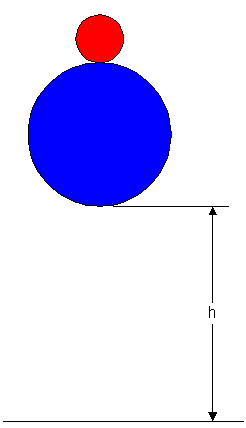Example: Double Ball Drop
 Consider two balls of masses M and m, dropped together from an initial height h, where one of the balls sits directly atop the other.
The balls rebound from the floor and from each other elastically.
How far up will the upper ball bounce after they hit the floor?
Consider the special case of M >> m.
Consider two balls of masses M and m, dropped together from an initial height h, where one of the balls sits directly atop the other.
The balls rebound from the floor and from each other elastically.
How far up will the upper ball bounce after they hit the floor?
Consider the special case of M >> m.
Let the ball with mass m be atop the ball with mass M. Consider the rebound from the floor as a two separate collisions, first the lower ball (M) collides with the floor and rebounds, then the two balls collide with each other. These two collisions are separated by an infinitisimal time, but this is the easiest way to break the problem into a set of one-on-one collisions.
 Both balls fall with the same acceleration, so just before the collisions occur both balls have the same downward velocity, vi = -sqrt(2gh).
The lower ball (M) collides elastically with the floor, and rebounds with an equal but opposite velocity Vi = sqrt(2gh).
Both balls fall with the same acceleration, so just before the collisions occur both balls have the same downward velocity, vi = -sqrt(2gh).
The lower ball (M) collides elastically with the floor, and rebounds with an equal but opposite velocity Vi = sqrt(2gh).
Next, the two balls collide, the lower ball (M) now moving upward with velocity Vi = sqrt(2gh), and the upper ball (m) moving downward with velocity vi = -sqrt(2gh). Call the final velocities Vf for the lower ball (M) and vf for the upper ball (m). Conservation of momentum gives MVi + mvi = MVf + mvf, and conservation of energy gives ½MVi² + ½mvi² = ½MVf² + ½mvf². The first expression can be rewritten to give M(Vi - Vf) = m(vf - vi), and the second can be written as M(Vi² - Vf²) = M(Vi - Vf)(Vi + Vf) = m(vf² - vi²) = m(vf - vi)(vf + vi), and making use of the rewritten first expression this becomes (Vi + Vf) = (vf + vi).
Now let's use the fact that vi = -Vi. With this, the first relation can be written (M-m)Vi = MVf + mvf, and the second becomes 2Vi = vf - Vf. Use the second to eliminate Vf from the first and find (3M-m)Vi = (M+m)vf, or finally the desired result vf = Vi(3M-m)/(M+m). Unless m > 3M, this final velocity is upward and the upper ball will rebound to a height hf = vf²/2g = h[(3M-m)/(M+m)]²
For the special case that M >> m, the result becomes hf = 9h, that is, for the case that the upper ball is much less massive than the lower ball, it rebounds to 9 times the height it was dropped from. This is a rather surprising result and can be readily demonstrated -- but be careful of people, lights, and the ceiling!
This result also has application to supernova explosions. When a massive star burns as much of its fuel as possible, it stops fusing nuclei, and stops generating energy in its core. The temperature of the core drops, and the pressure in the core decreases. That pressure previously counteracted the gravitational weight of the overlying material, and when it decreases, the star collapses under its own weight. The outer material of the star collides with the small, dense core, and rebounds with enormous speed, like the upper ball in this example. The whole process happens so quickly that the rebounding material creates an explosion.